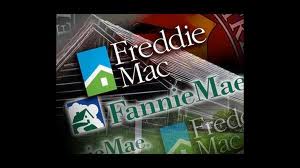To prevent the subterfuge and unrestrained greed that ruled the secondary mortgage market in the days before the credit crunch and the housing market crash, the United States Federal Housing Finance Agency (FHFA) is working on a new, transparent system that will consolidate all mortgage-backed securities into a single platform that will include Fannie Mae and Freddie Mac.
 To prevent the subterfuge and unrestrained greed that ruled the secondary mortgage market in the days before the credit crunch and the housing market crash, the United States Federal Housing Finance Agency (FHFA) is working on a new, transparent system that will consolidate all mortgage-backed securities into a single platform that will include Fannie Mae and Freddie Mac.
To prevent the subterfuge and unrestrained greed that ruled the secondary mortgage market in the days before the credit crunch and the housing market crash, the United States Federal Housing Finance Agency (FHFA) is working on a new, transparent system that will consolidate all mortgage-backed securities into a single platform that will include Fannie Mae and Freddie Mac.
The FHFA has been accepting comments and ideas on the proposed platform. The Mortgage Finance Working Group, an organization that advocates fair housing and lending for all Americans, recently submitted comments that are supported by the National Housing Conference, the Consumer Federation of America and the National Council of La Raza. The Mortgage Finance Working Group is concerned that Fannie and Freddie are shouldering too much mortgage investment responsibility, and that it is time to start welcoming private mortgage investors back into the secondary market if they are willing to submit to certain conditions that promote liquidity, transparency, affordability, and protection for consumers.
Here are the five points proposed by the Group:
1 – The mortgage securities platform shall be under the control of the government, in a similar way to that of an electric utility company. The FHFA would provide oversight and market makers will pay a fee to provide access and service to private investors.
2 – The platform should be all-encompassing, meaning that all securities backed by a mortgage made in the United States shall be tied to this platform. This will guarantee liquidity and fair participation, essentially making the platform a public market.
3 – Fees charged to market participants should be sufficient to cover the cost of administration and expansion of the secondary market.
4 – Disclosures with regard to the risk of investing in mortgage-backed securities should be even more extensive and explanatory than those given to mortgage borrowers. Enforcement of these disclosures by means of data collection and monitoring is essential to prevent the systemic failure experienced prior to 2008.
5 – Monitoring of disclosures, financial operations and market activity should be augmented by a system that provides sufficient checks and balances. This means that the platform should not operate without a proper loss mitigation strategy in place.
A strong secondary mortgage market is essential for the housing market and the overall American economy that has become so dependent on the well-being of its real estate and mortgage industries. Unrestrained financial activity in the early 21st century ended up in disaster, something the FHFA is intent on preventing with its proposed platform.



